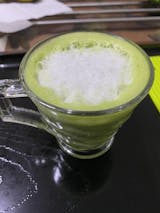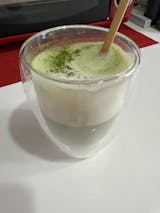Introductory Workshop: Making Matcha
Start making Matcha at home with our 5-lesson, introductory workshop.

15 Min Read
17 Min Read
- Lessons
- Recipes
- Other Guides
Introduction: Getting Started
Why Is This Important?
Matcha is a suspension, while most teas are infusions.
As Matcha particles are made from ground green tea, they do not dissolve in water.
That's why a whisk is recommended for making Matcha. The motion of the whisk helps to suspend the Matcha.
This is also the reason for its unique taste and mouthfeel.
A good cup of Matcha has characteristics like:
Smooth mouthfeel
Has a layer of creamy froth
A vibrant green
Earthy, vegetal taste
Slightly sweet, mild or no bitterness
What You Need:
To get started, you should have the following or similar:

Matcha Powder
Matcha quality matters. Use at least ceremonial- or barista-grade Matcha for your Matcha Lattes.

Matcha Whisk
Avoid using a spoon. A multi-pronged Matcha Whisk helps to ensure even .

Matcha Bowl
Used to whisk Matcha. A spout helps with pouring and a curved base ensures no Matcha remains stuck in corners.

Matcha Sieve
Get rid of clumpy Matcha - use the Matcha sieve to sieve Matcha.
Lesson 1: Your Matcha Whisk

Whisk Preparation
When you first get your Matcha whisk, you'll notice that the bamboo tips of the Matcha whisk (both inner and outer) are tightly curled up.
You'll first need to get the tips to unfurl or 'bloom'.
This will help the whisk to adhere to the shape of the bowl better and prevent the Matcha from clumping up.
To do this, soak the new, unused bamboo whisk in a bowl of hot water.

Not all whisks 'bloom' the same.
If your 'bloomed' whisk doesn't look exactly like the image above, don't sweat it.
Not all whisks will unfurl to the same degree.
As whisks are handmade, some may be naturally wound tighter than others.
If your whisk is slightly more stubborn, try whisking it in hot water to loosen the prongs in the middle.
You can also try gently nudging the prongs in the middle with your fingers to get them to unfurl.
Continuous whisking over time will also cause the prongs to unfurl naturally.
Whisk Cleaning
After use, run the whisk prongs under tap water until no more Matcha particles are visible.
Alternatively, dip the whisk in a bowl of clean, warm water & repeat the whisking motion till it is clean.
Avoid:
- Using dishwashing liquid
- Using a kitchen scrub
- Leaving it in the dishwasher
Whisk Drying
Whisks are susceptible to mould as they are made from bamboo.
Make sure to air dry the whisk & keep it away from humid areas like the kitchen or bathroom.
To air-dry the bamboo whisk, you can lay it on its end such that the tips are in the air.

Alternatively, place the whisk on a whisk holder to dry & maintain its shape.
Do not place the whisk back into the container as the prongs have unfurled & will not fit well.

Whisk Storage
For storage, place the whisk on a whisk holder to maintain its shape.
This will help the whisk last longer.
What if my whisk has broken prongs, marks or discolouration?
As genuine Matcha whisks are handmade from natural bamboo, it is normal for marks & discolouration to appear - don’t worry, they are not a sign of damage.
Also, If you find one or two broken prongs, don’t chuck the whisk yet.
The whisk can usually last for about six months to a year with heavy usage; & it can still work well with a couple of shorter prongs.
Lesson 2: How to Whisk Matcha

A whisk and the right whisking technique are essential to an excellent cup of Matcha.
As Matcha particles do not dissolve in water, a whisk is needed to ensure that the Matcha particles are suspended in the mixture.
Stop Spooning (Don't use a spoon!) —
Instead of breaking up clumps, a spoon sometimes makes even more clumps.
Sieve Matcha
We recommend sieving Matcha every time.
Due to the small particle size, static electricity causes even the best Matcha to clump up when stored.
Sieving breaks up large clumps for a smoother mouthfeel.
Add Water (~176° F /~ 80° C)
We recommend adding the following amounts of water:
Matcha Latte: 2g of Matcha to ~60ml (¼ cup or 2 fl oz) of water
Why can't I use boiling water?
Do not use boiling water. Boiling water causes Matcha to become an infusion, bringing out bitter-tasting notes.
Use water around ~175° F / ~80° C.
For convenience, add some room teperature water before filling up the rest with water fresh off the boil.
Water that's too cool (below ~130° F / ~60° C) may result in a lack of froth.
Whisk in an M-Shaped Pattern
Whisk in an M-shape motion from side to side.
This allows the whisk to pick up Matcha particles from all corners of the bowl.
The result? Consistent, creamy layer of Matcha froth.

DON'T: Whisk in a Circle
Just like wine, Matcha needs to be aerated well.
The gaps between the prongs help to form air bubbles during whisking to create a delicious layer of froth.
This is not possible if you whisk Matcha in a circular motion.
The whisk is unable to reach all corners of the bowl (only the edges).
This cause the Matcha particles to clump together at the bottom of the bowl. and result in a powdery finish.
Does using a whisk really make a difference?
To put it simply–yes.
To produce Matcha, the entire tea leaf is stone-ground into a fine powder. This means you get all of the beneficial nutrients and antioxidants in Matcha!
However, Matcha cannot dissolve and will naturally form clumps. If you want to make a silky-smooth latte, you need to get rid of those clumps.
A Matcha Whisk does the job best. After all, that's what it was designed for!
Lesson 3: Making Your Own Matcha Latte

The Perfect Matcha Latte
After years of testing, we've distilled what we believe to be the most suitable Matcha Latte recipe for most:
- Sift 1 full teaspoon (about 3g) of Matcha Powder into a bowl
- Add 60ml (¼ cup) of hot water (non-boiling water preferred, about 70°C)
- Whisk the Matcha with a Matcha Whisk until a layer of froth appears
- Optional: Add 2 full teaspoons of sugar (or any other sweetener of choice) into the Matcha and mix well
- Pour in 60ml of your favourite milk (use 40ml of milk for a less milky version) in a cup
- Add the whisked Matcha slowly into the cup for a lovely gradient (*For iced Matcha latte, fill the cup with ¾ ice)
More Matcha, More Flavour
Some cafes are known to add a lot of Matcha to their Matcha Lattes - up to 5-8g in a single cup!
It's the equivalent of adding 2-3 shots of espresso into a single coffee.
This results in a more intense Matcha flavour, but it's a lot of caffeine at once.
(1 gram of Matcha has about 30mg of caffeine, or half an espresso shot).
If you find your Matcha Latte lacking the punch you feel at your local cafe, it's easy to increase the intensity by adding more Matcha.
Is a Matcha Latte actually healthy?
It depends on what is added to the latte.
Large amounts of additional sugar may make a Matcha Latte unhealthy. For example, Matcha milk teas from bubble tea shops use a lot of added sugar.
The type of milk used also matters. Usually, the most creamy types of milk are also the highest in fat, and adding too much may not be good for your calorie count. Dairy milk may also trigger inflammation.
For us, we believe using high-quality Matcha keeps your Matcha lattes healthy. With high-quality Matcha, you typically won't need sugar or high-fat milk for a healthy and delicious Matcha latte.
Dairy Alternatives
We are strong proponents of using milk alternatives for Matcha lattes.
Milk alternatives are now just as tasty as dairy, and are often healthier as they are lower in fat.
This applies especially if you're drinking Matcha for skin health.
Dairy has been known to increase skin inflammation, so we generally recommend avoiding dairy if this is the case for you.
- Cashew Milk
- Coconut Milk
- Oat Milk
- Soy Milk
- Almond Milk
Sweetener Alternatives
Try replacing normal sugar with lower-calorie alternatives.
Here are some of our recommendations:
- Liquid Monk Fruit Syrup
- Monkfruit Sweetener
- Erythritol
- Allulose
- Splenda
In our view, Allulose and Splenda taste the closest to actual sugar.
Syrup-based sweetener would also be more convenient for mixing into Matcha lattes.
Lesson 4: Common Matcha Mistakes
Mistake 1: Not sifting your Matcha powder
Mistake 2: Adding boiling water
Mistake 3: Storing Matcha in the open
Mistake 4: Leaving Matcha at room temperature
Why refrigerate Matcha if I haven't opened it?
Matcha is delicate. Due to its small particle size, Matcha quality can deteriorate over time, even if it's not yet opened.
That's especially the case in the summer, or in warm and humid climates.
That's also why many supermarket Matcha products don't taste too great - Matcha quality slowly deteriorates from the time they're placed on the shelf.
Of course, leaving it unrefrigerated for a few days or weeks won't lead to a noticeable difference.
However, if you plan to keep your Matcha for a longer period, then it's best to keep it refrigerated throughout.
Lesson 5: Matcha Appreciation Tips
What Makes Good Matcha?
Not Bitter
Usually not bitter, or very mild bitterness.
Intensity
Has an intense, earthy Matcha flavour (also known as 'umami').
Smooth Mouthfeel
Smooth to drink. No powdery sensation.
Vibrant Green
Usually a bright and vibrant green (instead of dirty yellow-green).**
Aromatic
Has a refreshing, grassy aroma when whisked.
**Good Matcha can change from green to yellow-green due to oxidation. Ensure your Matcha is kept refrigerated to prevent this.
Health Benefits of Matcha
Matcha: Rich In Antioxidants (EGCG)
Matcha has among the highest concentration of antioxidants among all foods, on a per gram basis:
15x that of Blueberries
10x that of Green Tea
7x that of Dark Chocolate
These are in the form of the green tea catechins, EGCG and EGC.
Reduces Acne
EGCG has been scientifically shown to reduce sebum production, which can help reduce acne.
It also has anti-inflammatory properties that can soothe irritated skin.
Improves Skin Complexion
EGCG can rejuvenate your skin, making it firmer.
This reduces the formation of wrinkles and fine lines.
EGCG also boosts collagen renewal, giving you a glowy, healthy complexion.
Reduces Stress and Anxiety
Matcha is also a great source of L-theanine, an amino acid known for having a calming effect on the mind.
Incorporating Matcha into your routine may help reduce anxiety and promote a state of calm and focus.
Join Vitaliti Rewards and save.
Enjoy automatic perks like cashback on every purchase, free gifts, and more.
Simply click the button below to sign up.













